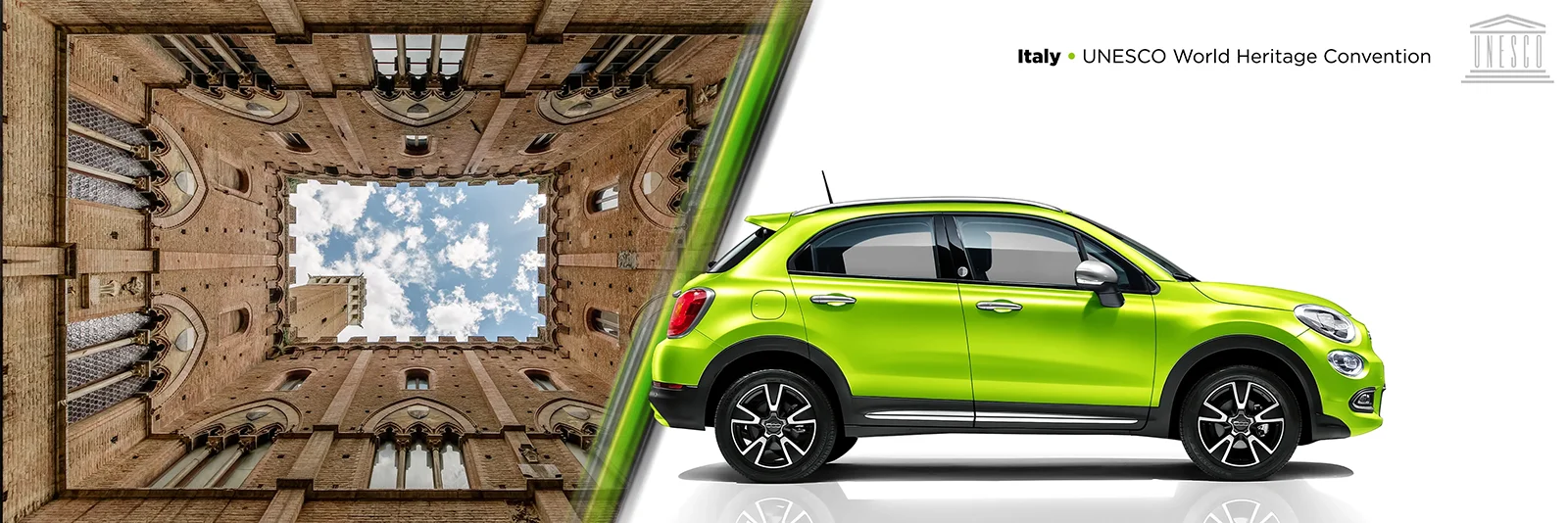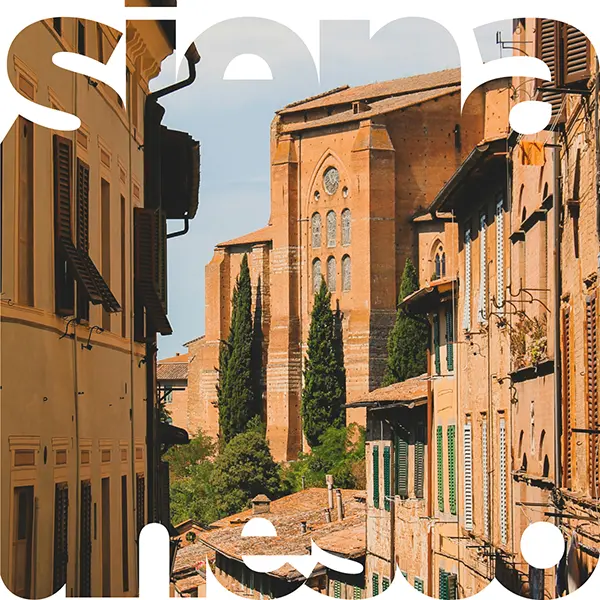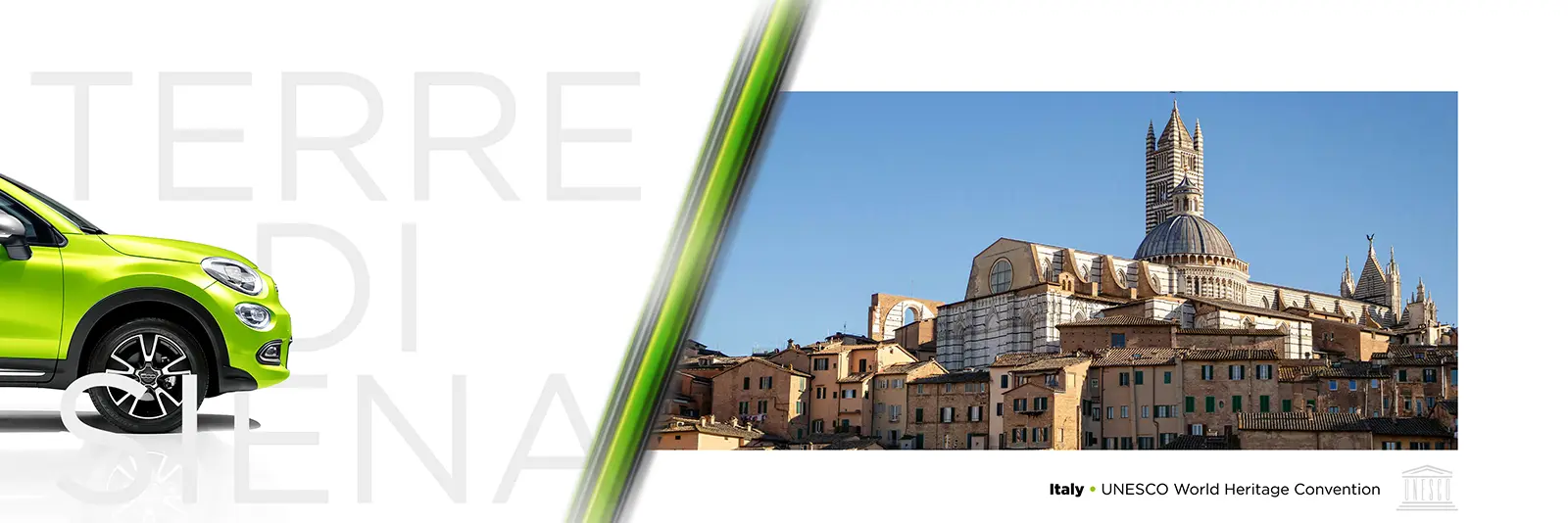IT
EN
ES
FR
IT
EN
ES
FR
Located in Tuscany, this ancient city captivates visitors with its beauty, history, and millennial culture.
Siena is famous for its outstanding medieval urban fabric, with the renowned Piazza del Campo at its heart, one of the most beautiful squares in Europe. Here, the famous Palio, a horse race drawing visitors from around the world, unfolds, representing an ancient tradition.
The city is enriched with monuments of great artistic value, such as the Cathedral of Santa Maria Assunta, a masterpiece of Italian Gothic art, and the Torre del Mangia, which stands imposingly beside the Cathedral, offering a delightful panoramic view of the city.
The historic center of Siena jealously preserves ancient traditions, like the Palio, and hosts important artworks and architectural treasures that narrate the history and ingenuity of the Sienese people throughout the centuries. Walking through its streets is an immersion into a fascinating past, an experience that captivates the soul of anyone who ventures there.
The UNESCO designation underscores the importance of preserving and celebrating this exceptional medieval city so that future generations can continue to discover and admire its extraordinary cultural and artistic heritage.

Siena, a city with a thousand colors, rich in history and culture, and possessing a nearly intact medieval charm, is nestled among the Tuscan hills. A city of intellect and an ideal destination for food lovers, Siena captivates even from a distance.
In 1995, UNESCO declared Siena a "masterpiece of dedication and inventiveness, in which the buildings have been designed to fit into the entire urban structure." The city has skillfully preserved important features of its medieval structure, which include a historic center enclosed by ancient walls built between the 14th and 16th centuries and a central square, Piazza del Campo, that leaves visitors in awe due to the abundance of monuments and sights to behold.
Siena's history began as a Roman military colony during the time of Emperor Augustus. However, it wasn't until the 10th century that Siena started gaining significant political and economic importance. The city was at the heart of vital trade routes, and it thrived, particularly during the turbulent years of conflict with nearby Florence. Great artists like Duccio di Boninsegna, Simone Martini, and the Lorenzetti brothers had the opportunity to express their art in the city. In 1240, the University of Siena was founded with schools of medicine and law, making it one of the world's oldest universities.
Siena reached the pinnacle of its splendor under the rule of the Government of Nine, which came to power in 1287 and held it until 1355. During these golden years, Siena initiated the construction of marvelous monuments such as the Cathedral, the Public Palace, and the Mangia Tower.
The decline of the Republic of Siena began with the plague epidemic in 1384, which claimed three-fifths of the population. Siena's pride has never wavered, and the city is still tied to the historic division into districts within the medieval walls. The same 17 districts, each year since 1644, compete twice a year on July 2nd and August 16th in the iconic Palio di Siena, a medieval equestrian joust held in Piazza del Campo.
Siena's historic center, preserved for centuries, now appears almost as it did in the 14th century. Exploring the city begins at the magnificent Piazza del Campo, surrounded by imposing monuments that will captivate you for hours.
From the heart of Siena's social life, after taking some photos to capture the vibrant red hues enhanced by the sunlight, start by climbing the Mangia Tower with its 400 steps, offering an unforgettable panoramic view of the square and Siena's rooftops. Then, visit the Public Palace, which houses the Civic Museum and features masterpieces like Simone Martini's Maestà and Ambrogio Lorenzetti's fresco cycle Effects of Good and Bad Government.
Fonte Gaia is the city's first public fountain, and it's worth a souvenir photo before you wander through the narrow streets to the monumental complex of the Siena Cathedral. An exceptional example of Italian Romanesque-Gothic cathedrals, the Cathedral houses sculptures by Nicola and Giovanni Pisano, Donatello, Michelangelo, and Bernini. With a single admission ticket, you can access the Piccolomini Library and the Porta del Cielo, which had been closed to the public for centuries. If you're lucky, you might also have the chance to admire the cathedral's floor, typically uncovered for a few weeks each year, usually between June-July and August-October.
Take your time to admire every corner of the Cathedral, including a visit to the crypt, and continue to the nearby Baptistery of San Giovanni, descending a few steps. With its completely frescoed rib-vaulted naves, the Baptistery is one of the finest examples of Sienese painting from the 15th century.
Siena, located in the heart of Tuscany, is a city that captivates with its history, art, and unique lifestyle. Its historic center, a UNESCO World Heritage Site, is not only famous for Piazza del Campo and the Palio, but also holds a series of hidden treasures worth discovering. For example, the Fonte Gaia, located in Piazza del Campo, is a remarkable marble masterpiece by Jacopo della Quercia. Strolling through the medieval streets, you’ll come across the Baptistery of San Giovanni, a hidden gem with stunning works by Ghiberti and Donatello. Another highlight is the Santa Maria della Scala Museum Complex, a former hospital now hosting art exhibitions and offering unique insights into the city's history. Panoramic enthusiasts shouldn’t miss the Facciatone, the unfinished structure of the Cathedral, offering spectacular views of the surrounding hills. Siena is not just about art: its contrade, with their centuries-old traditions, form the heartbeat of the city and make every corner unique and fascinating.
The areas around the historic center further enrich the experience. The Fortezza Medicea, located nearby, is perfect for relaxing walks and stunning views of the countryside. The Botanical Garden of the University of Siena provides a green oasis ideal for those seeking tranquility. In the surrounding areas, the Eremo di Lecceto, immersed in nature, and the Chianti vineyards allow visitors to explore the most authentic aspects of the territory. For those seeking relaxation, the Rapolano Thermal Baths offer an ideal retreat in the Sienese countryside. Siena and its surroundings combine culture, nature, and tradition into an unforgettable experience.

The monuments of Siena are among the most precious treasures of Tuscany, offering a unique combination of art, history, and tradition. The beating heart of the city is Piazza del Campo, one of the most iconic medieval squares in the world, famous for its shell-like shape and for hosting the renowned Palio di Siena. Here you’ll also find the Palazzo Pubblico, home to the Civic Museum, and the Torre del Mangia, which offers breathtaking views of the entire city. A short walk from the square, the majestic Siena Cathedral stands out, a Gothic masterpiece adorned with polychrome marble. Inside, you can admire works by Donatello, Pisano, and Michelangelo, as well as the intricately inlaid floor, a rare artistic marvel. Among Siena's monuments, the Baptistery of San Giovanni deserves special mention for its Renaissance font adorned by artists such as Ghiberti. Another must-visit site is the Santa Maria della Scala Museum Complex, once a hospital and now home to exhibitions and insights into medieval life. Walking through the UNESCO-listed historic center, you can also discover the National Art Gallery, preserving significant works of Sienese art, and numerous monumental churches, such as San Domenico, dedicated to St. Catherine, the patron saint of Italy. The contrade of Siena, with their small oratories and museums, represent a unique aspect of the city's culture. Outside the historic center, the Medici Fortress offers a scenic viewpoint and spaces for cultural events. Siena, with its monuments and surrounding areas, is not just a tourist destination but a journey through centuries of history and beauty, making it one of the most fascinating cities in Italy.
The contrade of Siena are the beating heart of the city and represent a tradition unique in the world, deeply rooted in Sienese history and culture. These 17 medieval districts are not just administrative divisions but true communities that pass down values, rivalries, and centuries-old celebrations. Each contrada has its own coat of arms, colors, territory, and patron saint, elements that define its identity and foster a strong sense of belonging among its inhabitants. The contrade find their ultimate expression in the famous Palio di Siena, the historic horse race held twice a year, on July 2nd and August 16th, in Piazza del Campo. During the Palio, the contrade compete in a race that is not just a sporting event but a ritual involving the entire city. Each contrada selects its horse and jockey, and the bond that forms between the contradaioli and their representative is a fundamental aspect of this tradition. In addition to the Palio, the contrade organize numerous cultural, social, and religious activities. Each contrada has its own church or oratory, where community-related ceremonies are held, and a museum that preserves relics, flags, and trophies won over the centuries. These spaces represent the historical memory of each contrada and are sources of great pride for the contradaioli. Walking through the streets of Siena, it is easy to spot the symbols of the contrade: decorated fountains, coats of arms carved on walls, and vibrant colors adorning the streets during the Palio. Among the most famous contrade are the Giraffe, the She-Wolf, the Goose, the Forest, and the Dragon, each with its own unique history and identity. The contrade of Siena are not just a folkloric aspect but a living reality that continues to unite generations of Sienese. For visitors, discovering this tradition means immersing themselves in the most authentic soul of Siena, unveiling a community that passionately preserves its history and culture.


The distinctive hills south of Siena represent one of the most iconic landscapes of Tuscany, offering a perfect combination of nature, history, and culture. This area, also known as the Crete Senesi, is famous for its gentle undulations, cultivated fields, and picturesque villages that seem frozen in time.
The distinctive hills south of Siena are renowned for their unique appearance, shaped by erosion and agricultural activities over the centuries. These hills, formed from clay and sand, are distinguished by their colorful hues ranging from gray to golden, creating an almost lunar-like landscape. This natural environment is dotted with cypress trees, oaks, and vineyards, adding touches of green to the panorama.
Among the distinctive hills south of Siena lie some of Tuscany’s most charming villages. These include Montalcino, famed for its Brunello wine, and Montepulciano, renowned for Vino Nobile. Each village is rich in history, art, and culinary traditions that tell the long cultural legacy of this region.
Visiting the distinctive hills south of Siena offers numerous opportunities for unique experiences. From hiking or biking along the scenic trails, to tasting fine wines in ancient cellars, to guided tours of castles and abbeys that dominate these lands, each activity allows you to connect with the authentic essence of Tuscany.
The distinctive hills south of Siena are often captured in photographs and paintings due to their breathtaking beauty. Their gentle curves, changing colors, and shifting light throughout the day create a magical atmosphere, making this area one of the most photographed in Italy. Visitors to these hills can enjoy spectacular views and unparalleled tranquility.
The distinctive hills south of Siena are a corner of Tuscany that enchants with its unique landscape, rich history, and culinary traditions. Whether you’re a photography enthusiast, nature lover, or foodie, these hills offer an unforgettable experience in the heart of Tuscany. Don’t miss the chance to discover this wonderful territory and immerse yourself in its timeless beauty.
In Siena, as in many Italian cities, preferred cars vary based on mobility needs and the urban context. Generally, the most appreciated vehicles tend to be compact models, ideal for navigating the historic center, which features narrow streets and often pedestrian zones. Some of the most chosen models include:
Fuel efficiency and maneuverability are important criteria for drivers in Siena, given the city's terrain and urban traffic regulations.
The Fiat 500 Electric is becoming increasingly popular in Siena for its compact size, ideal for the narrow streets of the historic center, and for its ability to reduce emissions, aligning with the city's environmental policies. Additionally, unrestricted access to ZTL (limited traffic zones) and incentives for electric vehicles make it a practical and sustainable choice for those who live and work in the city.

Siena is surrounded by some of the most fascinating UNESCO World Heritage Sites in Tuscany, each with its own unique history and beauty. About 40 km from Siena lies San Gimignano, famous for its medieval towers that dominate the landscape, offering a living testimony to medieval civilization. San Gimignano is an open-air museum, with its stone-paved streets, ancient wells, and fountains that tell stories of a distant past. Heading south, about 53 km from Siena, you will find Pienza, known as the "ideal city" of the Renaissance. This small jewel was designed by Pope Pius II according to the humanistic principles of the Renaissance, featuring a trapezoidal central square surrounded by historic buildings like the Duomo and Palazzo Piccolomini. The view from the palace’s garden, overlooking the Val d'Orcia, is simply breathtaking. The Val d'Orcia, about 50 km from Siena, is another UNESCO treasure. This enchanting landscape, characterized by rolling hills, cypress trees, and vineyards, was reshaped during the Renaissance to reflect ideals of good governance and aesthetic beauty. Its vistas have been immortalized by the painters of the Sienese School and continue to inspire visitors from all over the world. These UNESCO sites tell age-old stories of thermal care, cultural and architectural traditions, and a profound relationship between humanity and natural resources. The thermal complexes, often set in scenic natural landscapes, serve as a testament to how communities have developed a deep understanding of the healing benefits of thermal waters since ancient times. The thermal baths represent places of healing, relaxation, and socialization, blending the therapeutic dimension with the social and cultural one. The architecture of the spa towns reflects the style and trends of the era in which they were developed, offering a journey through time with historic buildings, squares, gardens, and thermal establishments. Together, they create a unique experience that goes beyond physical well-being, embracing the cultural richness of the populations that inhabited them. The UNESCO recognition emphasizes the importance of preserving these spa towns for future generations, encouraging the conservation and enhancement of their unique features. Promoting sustainable management, combining tradition and innovation, is essential to ensure that this precious heritage continues to enrich our world and benefit people in a harmonious and responsible way.
The name Siena has ancient origins, and several theories explain its meaning. One of the most widely accepted hypotheses connects it to the Roman colony Saena Julia, founded in the 1st century BC. Others believe it derives from the legend of Senio and Aschio, sons of Remus, who founded the city after fleeing from Rome. There is also a theory suggesting an Etruscan origin, though the precise meaning in the Etruscan context remains uncertain.
The river that flows near Siena is the Arbia, famously mentioned in Dante's Divine Comedy and known for the historic Battle of Montaperti. Also nearby is the Ombrone River, one of the main waterways in Tuscany, which crosses the Sienese countryside on its way to the Tyrrhenian Sea.
In Siena, the term Opa is the acronym for Opera della Metropolitana, the organization responsible for managing and preserving the Duomo of Siena and its monumental complex. Founded in 1180, the Opa is in charge of the maintenance of the Cathedral of Santa Maria Assunta and its artworks, ensuring the protection of the city's historical and cultural heritage.
According to legend, the city of Siena was founded by the brothers Senio and Aschio, sons of Remus, one of the mythical founders of Rome. Fleeing from Rome, the brothers are said to have given the city the name "Siena." Historically, however, the foundation of Siena is attributed to the Etruscans and later developed by the Romans as a colony called Saena Julia.
The hills south of Siena, in the Val d'Orcia and the Crete Senesi, offer unique and captivating landscapes. The Val d'Orcia is characterized by gentle hills dotted with cypress trees, vineyards, olive groves, and medieval villages such as Pienza, Montalcino, and San Quirico d'Orcia. The Crete Senesi, on the other hand, present a more arid and distinctive landscape, with gullies and biancane that create a lunar-like appearance. The hills of the Crete Senesi are famous for their clayey soil and gray-blue hues. Both areas offer dreamlike settings for those seeking nature, history, and tranquility in Tuscany.